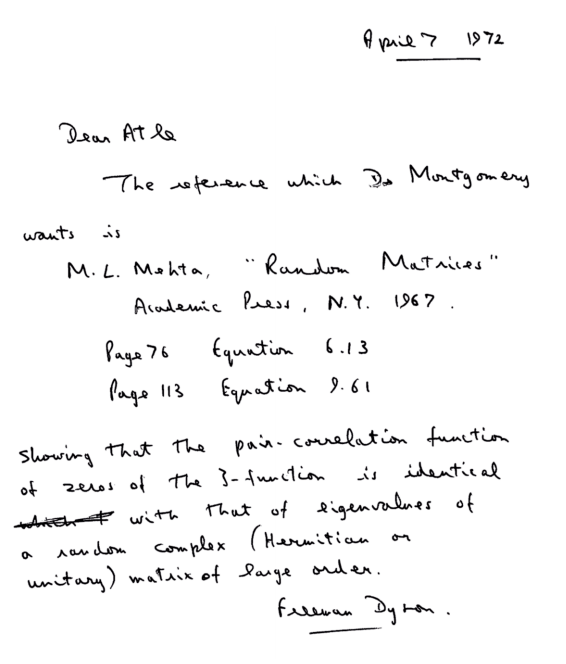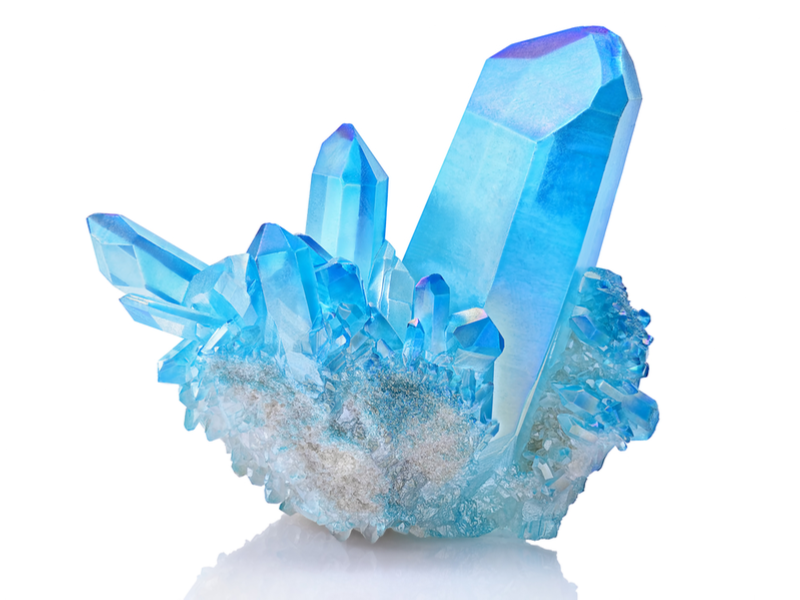It is wholly hilarious that I got to this point in studying prime numbers before I learned of the quasicrystalline nature of prime numbers, which was discovered by Freeman Dyson while in idle conversation with Hugh Montgomery over lunch one day in the early 1970s. I knew of the legendary conversation, but first learned of it well before I had an overall grasp of where prime numbers and the Riemann Hypothesis sit in relation to the rest of mathematics. And long before I began to understand what an eigenvalue is. I remember thinking "I've got to learn what eigenvalues are." (The famous quote happened at the mention of 1 - [(sin pi*u)/(pi*u)]2, when Dyson said: 'Hey, that's the density of the pair correlation of eigenvalues of random matrices in the Gaussian Unitary Ensemble.') 
So I knew that Freeman Dyson had made a keen observation that mentioned eigenvalues, but didn't know it was related to quasicrystals, didn't remember it was related to randomness, didn't know it was related to prime numbers, and at the time I learned of it, didn't know what an eigenvalue was, each of which I have studied independently from a number of different directions as I make my peripatetic walk through mathematics over the past decade and a half.
Until today.
Today, while working and idly watching yet another video on the Riemann Hypothesis (on the theory that I usually learn at least one new thing by looking at something familiar from another angle), I was startled by the reference to the connection to the conversation with Freeman Dyson. Oh, that conversation was related to prime numbers? Cool! How did I miss that? I quickly searched on the topic and pulled up a couple dozen webpages, each of which looks quite fascinating, and a quick skim of the first few has already got lightbulbs going off over my head. Alas, got work to do, so I'll reserve deeper comments for the future, but right now I'm just laughing out louad at myself for taking this long to discover that my intuitive hunch about the physics of prime numbers was already worked out decades ago. (I've encountered other "physics of prime numbers" theories from time to time, but none this credible.)
0. But wait -- before I go -- this is also the second major reference to the crystalline nature of That Which Underlies Everything. I long held a faint "no that can't be true" intuitive hunch that the nature of the primordial substance out of which everything is created (desire? aether? consciousness? definitely not strings) is crystalline in nature. It probably is rooted in "the sea of glass like crystal" which is before the throne of God, but it appears from time to time in thought experiments on the nature of Everything, only to be quickly dismissed because crystals in my mind are rigid, unmoving, and this doesn't strike me as an apt description of God, or heaven, which to me are the quintessence of motion, energy, life, action. 
1. Oops, I guess I'm actually talking about the "first major reference" in my experience to the crystalline nature of That Which Underlies Everything, because the second one is in Schrödinger's small book What Is Life described beautifully in a chapter of another book I'm reading about quantum biology. I discovered this only a few weeks ago (he was describing DNA a decade before it was discovered as "an aperiodic crystal)," and this made the crystalline nature of the prime substance more likely. My thought experiments stopped dismissing the crystal structure so quickly.
2. And then, a few days ago, while searching on the meaning of the word "tensor" because I've fallen in love with how it is a better tool for understanding measurement than the ridiculously flawed Euclidian approach, I discover to my jaw-dropping astonishment that the person who first used the term in the way it is commonly used today was Woldemar Voigt, an expert in crystals. Crystals? I thought tensors flowed, do crystals flow? A lot fell into place when I discovered this, and new questions about the nature of crystals began to form. So now it's not a matter of letting the underlying crystal structure remain a little longer in thought experiments... it's a matter of beginning to devote entire thought experiments to the underlying crystal structure.
3. And now... prime numbers are crystalline? Wow. Here we go. I know I've stumbled upon these insights in the past, just never saw them. Three independent references out of the blue in as many weeks lends an aura of grace to the adventure. It is part of the human condition that we are presented with deep insights continually, but are only able to see them when we're looking. I'm excited to see what comes next. Well the whole point of this post was to pull together in a single place a bunch of URLs that I will now start reading in earnest, so here we are, a few of the most interesting ones that appeared during the preliminary search: https://www.math.columbia.edu/~woit/wordpress/?p=1506 https://www.ias.edu/ideas/2013/primes-random-matrices <-- this one looks good all the way through
- http://empslocal.ex.ac.uk/people/staff/mrwatkin//zeta/dyson.htm
- https://en.wikipedia.org/wiki/Montgomery%27s_pair_correlation_conjecture
- https://golem.ph.utexas.edu/category/2013/06/quasicrystals_and_the_riemann.html https://www.americanscientist.org/article/the-spectrum-of-riemannium
- https://news.ycombinator.com/item?id=6541886 https://www.dartmouth.edu/~chance/chance_news/recent_news/primes_part3.pdf (PDF)
- https://mathoverflow.net/questions/54501/riemann-zeta-function-connection-to-quantum-mechanics
- https://www.wired.com/2013/02/math-and-nature-universality/ http://guava.physics.uiuc.edu/~nigel/courses/563/Essays_2008/PDF/lyon.pdf (PDF)
- http://www.ams.org/publicoutreach/math-history/prime-chaos.pdf (PDF)
- https://icerm.brown.edu/materials/Abstracts/sp-s13-w3/Random_Matrix_theory_and_the_zeros_of_the_Riemann_zeta-function_]_Brian_Conrey,_American_Institute_of_Mathematics.pdf (PDF)
- https://arxiv.org/pdf/1305.3342.pdf (PDF)
- https://www.seedmagazine.com/content/article/prime_numbers_get_hitched/
- https://math-frolic.blogspot.com/2013/05/riemann-dyson-montgomery-quasi-crystals.html
- https://web.williams.edu/Mathematics/sjmiller/public_html/math/papers/sym1010064.pdf (PDF)
- https://www.vice.com/en_us/article/4x3me3/quasicrystals-are-natures-impossible-matter
- https://journals.plos.org/plosbiology/article?id=10.1371/journal.pbio.0020448
There, that ought to be enough to get started... now, back to work.